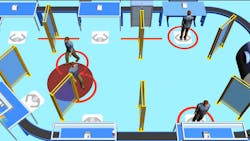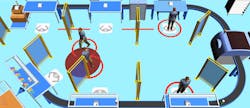Siemens Software Launch Helps Manage Plant Social Distancing
Manufacturers have said for years that line workers were their most important asset. In the age of COVID-19, they now can track employees to maintain social distancing with the same technology used to track other assets in the plant.
Siemens announced June 4 a workplace distancing solution that uses existing software and sensor technology to simulate worker movement in the plant, maintain continuing social distancing guidelines and alert workers when those guidelines are being breached.
The Siemens Real Time Locating Systems (RTLS) solution already exists, so company officials said it can be added quickly as either a software upgrade or deployment. Combined with wearable sensors, the system can first simulate how workers in a given cell might operate, determine optimal plant layouts and then continue to alert workers and supervisors when employees are too close to one another.
“We have to prepare for the new normal,” said Del Costy, senior vice president and managing director, Americas at Siemens Digital Industries Software. “But we still have to be able to ramp back up. Being able to do simulation, validation and iteration is going to be critical. We’re taking our portfolio of proven solutions and applying them to this.”
Raj Batra, president of Digital Industries for Siemens USA, noted that the RTLS system also would assist with contract tracing should a COVID-19 case be reported at a plant. “This is off-the-shelf technology,” Batra said. “These are not complex rollouts. Whether it is a simulation model or deployment of RTLS system, we want to get to as many people as possible.”
Siemens officials said the system addressed two important consideration for workers: limits and anonymity. The RTLS system can be utilized in work spaces, but there could be areas of the plant such as restrooms where tracking might not take place. Also, the system is designed to track data anonymously, leaving it to company officials to determine how best to track and manage the individual employees.
One area of emphasis was in determining hot spots and other areas of worker interaction before workers step on the floor. “We want to drive a continual iteration of data,” Costy said. “Whether we’re looking at traffic interactions or product flow, now that we have this digital thread, we have this opportunity to identify issues as they come up.”


